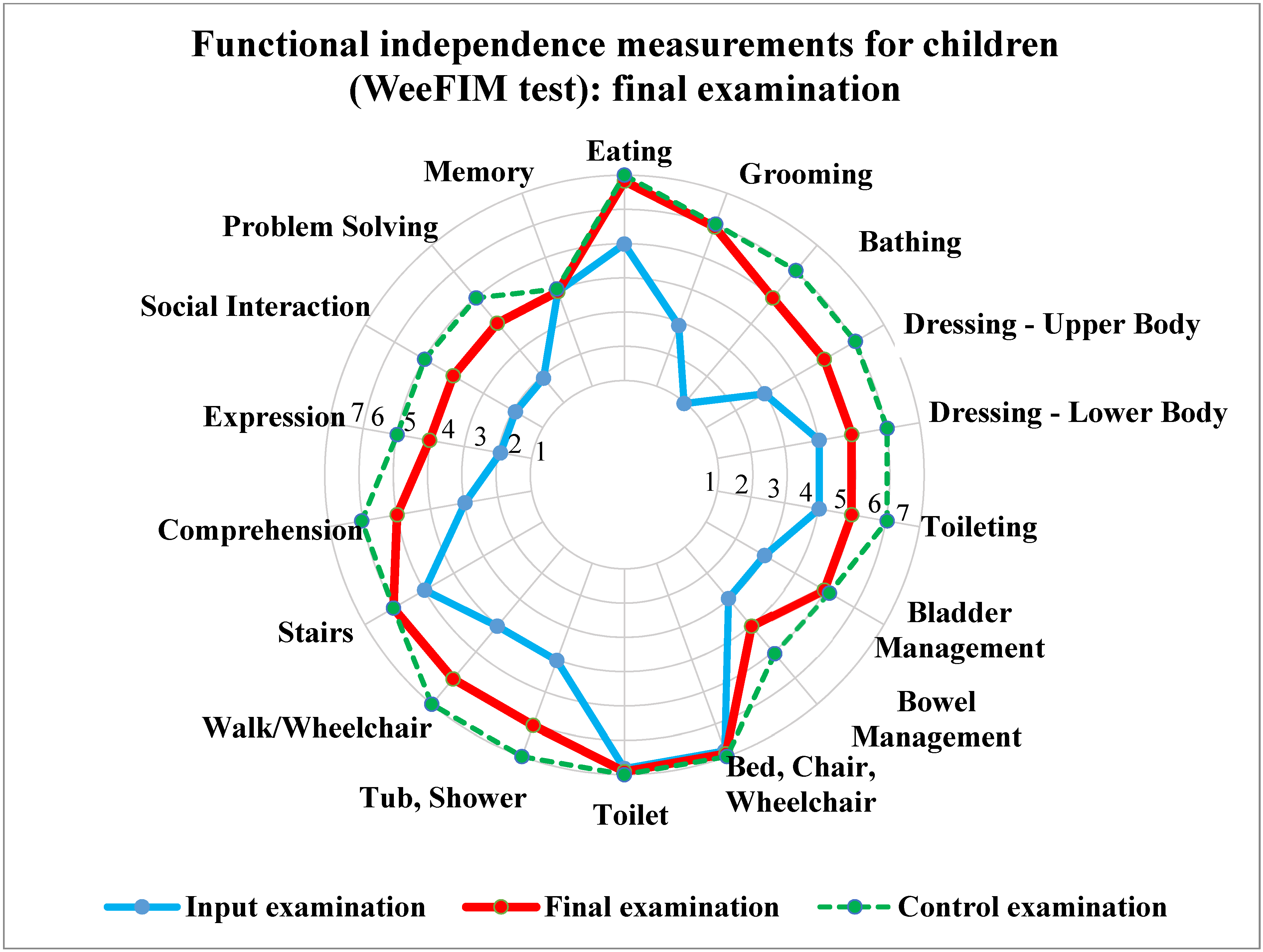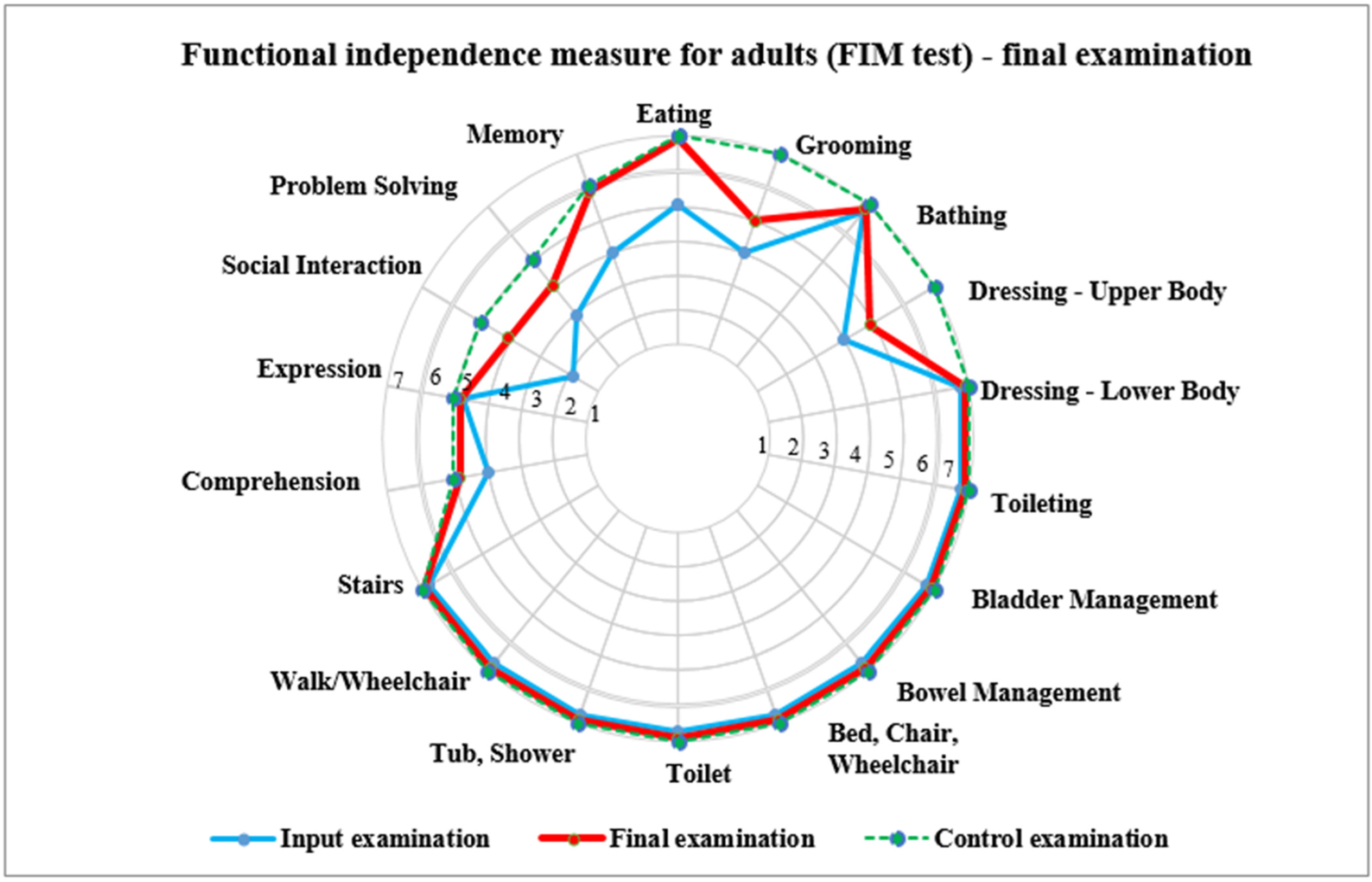Assessment of the Functional Level of Independence in Individuals with Mental Disabilities as Part of Special Education Diagnostics: Case Studies
Abstract
1. Introduction
1.1. Social Adaptability
1.2. Selected Intervention Approaches
2. Case Description
2.1. Summary of the Results
2.2. Application of Special Pedagogical Intervention
3. Discussion
4. Conclusions
- In the event that several experts have an influence on a given individual, would each expert carry out testing with his own test? Or, is it possible to apply the results from one test and based on this adapt the intervention of special pedagogy, occupational therapy, physiotherapy, etc.?
- Is it possible to use the given test immediately, without knowledge and experience?
Author Contributions
Funding
Institutional Review Board Statement
Informed Consent Statement
Data Availability Statement
Conflicts of Interest
References
- Patel, D.R.; Greydanus, D.E.; Calles, J.L., Jr.; Pratt, H.D. Developmental disabilities across the lifespan. Dis. Mon. 2010, 56, 304–397. [Google Scholar] [CrossRef] [PubMed]
- Patel, D.R.; Apple, R.; Kanungo, S.; Akkal, A. Intellectual functional diversity: Definitions, evaluation and principles of treatment. Pediatr. Med. 2018, 1, 11. [Google Scholar] [CrossRef]
- Harris, J.C. Intellectual Functional Diversity: Understanding Its Development, Causes, Classification, Evaluation, and Treatment; Oxford University Press: Oxford, UK, 2006; ISBN 9780195178852. [Google Scholar]
- Patel, D.R.; Cabral, M.D.; Ho, A.; Merrick, J. A clinical primer on intellectual functional diversity. Transl. Pediatr. 2020, 9 (Suppl. 1), S23–S35. [Google Scholar] [CrossRef] [PubMed]
- Haroková, M.; Chrastina, J. Dying pupil with life-limiting or life-threatening illness in the context of inclusive education: A theoretical framework. EduPort 2022, 6, 27–37. [Google Scholar] [CrossRef]
- Ladislav, Z.; Chytrý, V.; Lanková, B. The Influence of Teacher’s Competences on Pupils’ Attitudes towards People with Disabilities. EduPort 2019, 3, 37–45. [Google Scholar] [CrossRef]
- Schalock, R.L.; Borthwick-Duffy, S.A.; Bradley, V.J.; Buntinx, W.H.E.; Coulter, D.L.; Craig, E.M.; Gomez, S.C.; Lachapelle, Y.; Luckasson, R.; Reeve, A.; et al. Intellectual Disability: Definition, Classification, and Systems of Supports, 11th ed.; American Association for Intellectual and Developmental Disabilities: Washington, DC, USA, 2009; ISBN 978-1-9353-0404-3. [Google Scholar]
- Vostrý, M.; Lanková, B.; Pešatová, I.; Fleischmann, O.; Jelínková, J. Nonpharmacological Compensation of Aggressive Behavior of Individuals with Moderate Intellectual Functional diversity and Behavioral Disorders—A Case Study. Int. J. Environ. Res. Public Health 2022, 19, 9116. [Google Scholar] [CrossRef]
- American Psychiatric Association (APA). Diagnostic and Statistical Manual of Mental Disorders (DSM-5); American Psychiatric Association Publishing: Washington, DC, USA, 2013; ISBN 9780890425558. [Google Scholar]
- World Health Organization (WHO). The ICD-10 Classification of Mental and Behavioural Disorders: Clinical Descriptions and Diagnostic Guidelines; World Health Organization: Geneva, Switzerland, 1992; Volume 1, ISBN 9241544228.
- Shapiro, B.K.; Gallico, R. Learning Disabilities. Pediatr. Clin. N. Am. 1993, 40, 491–505. [Google Scholar] [CrossRef]
- Torr, J.; Davis, R. Ageing and mental health problems in people with intellectual functional diversity. Curr. Opin. Psychiatry 2007, 20, 467–471. [Google Scholar] [CrossRef]
- Girimaji, S.C.; Srinath, S. Perspectives of intellectual functional diversity in India: Epidemiology, policy, services for children and adults. Curr. Opin. Psychiatry 2010, 23, 441–446. [Google Scholar] [CrossRef]
- De Ligt, J.; Willemsen, M.H.; Van Bon, B.W.; Kleefstra, T.; Yntema, H.G.; Kroes, T.; Vulto-van Silfhout, A.T.; Koolen, D.A.; De Vries, P.; Gilissen, C.; et al. Diagnostic exome sequencing in persons with severe intellectual functional diversity. N. Engl. J. Med. 2012, 367, 1921–1929. [Google Scholar] [CrossRef]
- Chadwick, O.; Walker, N.; Bernard, S.; Taylor, E. Factors affecting the risk of behaviour problems in children with severe intellectual functional diversity. J. Intellect. Funct. Divers. Res. 2000, 44, 108–123. [Google Scholar] [CrossRef] [PubMed]
- Arvio, M.; Sillanpää, M. Prevalence, aetiology and comorbidity of severe and profound intellectual functional diversity in Finland. J. Intellect. Funct. Divers. Res. 2003, 47, 108–112. [Google Scholar] [CrossRef] [PubMed]
- Lee, K.; Cascella, M.; Marwaha, R. Intellectual Functional diversity. In StatPearls; StatPearls Publishing: Treasure Island, FL, USA, 2019. [Google Scholar]
- Huang, J.; Zhu, T.; Qu, Y.; Mu, D. Prenatal, Perinatal and Neonatal Risk Factors for Intellectual Functional diversity: A Systemic Review and Meta-Analysis. PLoS ONE 2016, 11, e0153655. [Google Scholar] [CrossRef]
- Maulik, P.K.; Mascarenhas, M.N.; Mathers, C.D.; Dua, T.; Saxena, S. Prevalence of intellectual functional diversity: A meta-analysis of population-based studies. Res. Dev. Disabil. 2011, 32, 419–436. [Google Scholar] [CrossRef]
- Forster, S.; Iacono, T. Functional diversity support workers’ experience of interaction with a person with profound intellectual functional diversity. J. Intellect. Dev. Funct. Divers. 2008, 33, 137–147. [Google Scholar] [CrossRef] [PubMed]
- Vehmas, S. Persons with profound intellectual functional diversity and their right to sex. Funct. Divers. Soc. 2019, 34, 519–539. [Google Scholar] [CrossRef]
- Jacobs, P.; Macmahon, K.; Quayle, E. Transition from school to adult services for young people with severe or profound intellectual functional diversity: A systematic review utilizing framework synthesis. J. Appl. Res. Intellect. Disabil. 2018, 31, 962–982. [Google Scholar] [CrossRef]
- Kjellberg, A. Participation—Ideology and Everyday Life: How to Understand the Experiences of Persons with Learning Disabilities; Linköping University: Linköping, Sweden; Örebro University: Örebro, Sweden, 2002; ISBN 9173733717. [Google Scholar]
- Kottorp, A.; Bernspang, B.; Fisher, A.G. Activities of daily living in persons with intellectual functional diversity: Strengths and limitations in specific motor and process skills. Aust. Occup. Ther. J. 2003, 50, 195–204. [Google Scholar] [CrossRef]
- Reschly, D.J.; Myers, T.G.; Hartel, C.R. (Eds.) Mental Retardation—Determining Eligibility for Social Security Benefits; National Academy Press: Washington, DC, USA, 2002. [Google Scholar]
- Stauffer, L.M.; Fisher, A.G.; Duran, L. ADL performance of black Americans and white Americans on the Assessment of Motor and Process Skills. Am. J. Occup. Ther. 2000, 54, 607–613. [Google Scholar] [CrossRef][Green Version]
- Ottenbacher, K.J.; Msall, M.E.; Lyon, N.; Duffy, L.C.; Ziviani, J.; Granger, C.V.; Braun, S.; Feidler, R.C. The WeeFIM instrument: Its utility in detecting change in children with developmental disabilities. Arch. Phys. Med. Rehabil. 2000, 81, 1317–1326. [Google Scholar] [CrossRef]
- DiScala, C.; Grant, C.C.; Brooke, M.M.; Gans, B. Functional outcome in children with traumatic brain injury: Agreement between clinical judgement and the functional independence measure. Am. J. Phys. Med. Rehabil. 1992, 7, 145–148. [Google Scholar] [CrossRef] [PubMed]
- Graham, J.E.; Granger, C.; Karmarkar, A.; Deutsch, A.; Niewczyk, P.; DiVita, M.; Ottenbacher, K. The Uniform Data System for Medical Rehabilitation: Report of Follow-up Information on Patients Discharged from Inpatient Rehabilitation Programs in 2002–2010. Am. J. Phys. Med. Rehabil. 2014, 93, 231–244. [Google Scholar] [CrossRef] [PubMed]
- Kauffman, J.M.; Hung, L.Y. Special education for intellectual functional diversity: Current trends and perspectives. Curr. Opin. Psychiatry 2009, 22, 452–456. [Google Scholar] [CrossRef]
- Jacobson, J.W.; Mulick, J.A.; Rojahn, J. Handbook of Intellectual and Developmental Disabilities; Springer: New York, NY, USA, 2007; ISBN 978-0-387-32930-7. [Google Scholar]
- Graves, T.B.; Collins, B.C.; Schuster, J.W.; Kleinert, H. Using video prompting to teach cooking skills to secondary students with moderate disabilities. Educ. Train. Dev. Disabil. 2005, 40, 34–46. [Google Scholar]
- Cannella-Malone, H.I.; Fleming, C.; Chung, Y.-C.; Wheeler, G.M.; Basbagill, A.R.; Singh, A.H. Teaching Daily Living Skills to Seven Individuals with Severe Intellectual Disabilities: A Comparison of Video Prompting to Video Modeling. J. Posit. Behav. Interv. 2011, 13, 144–153. [Google Scholar] [CrossRef]
- Patel, D.R.; Merrick, J. Intellectual functional diversity. In Neurodevelopmental Disabilities; Springer: Dordrecht, Germany, 2011; pp. 161–171. ISBN 978-94-007-0626-2. [Google Scholar]
- Lifshitz, H.; Merrick, J.; Morad, M. Health status and ADL functioning of older persons with intellectual functional diversity: Community residence versus residential care centers. Res. Dev. Disabil. 2008, 29, 301–315. [Google Scholar] [CrossRef]
- Bhamani, S.; Makhdoom, A.Z.; Bharuchi, V.; Ali, N.; Kaleem, S.; Ahmed, D. Home learning in times of COVID: Experiences of parents. J. Educ. Educ. Dev. 2020, 7, 9–26. [Google Scholar] [CrossRef]
- Luckasson, R.; Borthwick-Duffy, S.; Buntinx, W.H.; Coulter, D.L.; Craig, E.M.P.; Reeve, A.; Schalock, R.L.; Snell, M.E.; Spitalnik, D.M.; Spreat, S.; et al. Mental Retardation: Definition, Classification, and Systems of Support, 10th ed.; American Association on Mental Retardation: Washington, DC, USA, 2002; ISBN 0-940898-81-0. [Google Scholar]
- Sulistyaningrum, N.D.; Mumpuniarti, M.; Nurkhamid, N. Development of activity of daily living modules based on behavioral approaches for moderate intellectual functional diversity. J. Prima Edukasia 2021, 9, 1–15. [Google Scholar] [CrossRef]
- Kang, Y.; Chang, Y. Using a motion-controlled game to teach four elementary school children with intellectual disabilities to improve hand hygiene. J. Appl. Res. Intellect. Disabil. 2019, 32, 942–951. [Google Scholar] [CrossRef]
- Lin, M.L.; Chiang, M.S.; Shih, C.H.; Li, M.F. Improving the occupational skills of students with intellectual functional diversity by applying video prompting combined with dance pads. J. Appl. Res. Intellect. Disabil. 2018, 31, 114–119. [Google Scholar] [CrossRef]
- Kellems, R.O.; Frandsen, K.; Hansen, B.; Gabrielsen, T.; Clarke, B.; Simons, K.; Clements, K. Teaching multi-step math skills to adults with disabilities via video prompting. Res. Dev. Disabil. 2016, 58, 31–44. [Google Scholar] [CrossRef] [PubMed]
- Mollica, R.L. State Medicaid Reimbursement Policies and Practices in Assisted Living. National Center for Assisted Living, American Health Care Association. 2009. Available online: https://www.ahcancal.org/Assisted-Living/Policy/Documents/MedicaidAssistedLivingReport.pdf (accessed on 9 September 2009).
- Maenner, M.J.; Smith, L.E.; Hong, J.; Makuch, R.; Greenberg, J.S.; Mailick, M.R. Evaluation of an activities of daily living scale for adolescents and adults with developmental disabilities. Funct. Divers. Health J. 2013, 6, 8–17. [Google Scholar] [CrossRef]
- Martins, R.; Assumpção, M.S.; de Bobbio, T.G.; Mayer, A.F.; Schivinski, C. The validity and reliability of the ADL-Glittre test for children. Physiother. Theory Pract. 2018, 35, 773–780. [Google Scholar] [CrossRef]
- Brown, K.; Parikh, S.; Patel, D.R. Understanding basic concepts of developmental diagnosis in children. Transl. Pediatr. 2020, 9, S9–S22. [Google Scholar] [CrossRef] [PubMed]
- Cobzaru, I. Models of intervention in the recovery of children with mental retardation and autism spectrum disorders. Alternative therapies. J. Plus Educ. 2021, 28, 99–109. [Google Scholar]
- Villa-Fernández, N.; Martín-Gutiérrez, Á. Educación inclusiva y digital: Desafíos y propuestas a partir del COVID-19. Virtu@lmente 2020, 8, 7–27. [Google Scholar] [CrossRef]


Publisher’s Note: MDPI stays neutral with regard to jurisdictional claims in published maps and institutional affiliations. |
© 2022 by the authors. Licensee MDPI, Basel, Switzerland. This article is an open access article distributed under the terms and conditions of the Creative Commons Attribution (CC BY) license (https://creativecommons.org/licenses/by/4.0/).
Share and Cite
Vostrý, M.; Lanková, B.; Pešatová, I.; Müllerová, L.; Vomáčková, H. Assessment of the Functional Level of Independence in Individuals with Mental Disabilities as Part of Special Education Diagnostics: Case Studies. Int. J. Environ. Res. Public Health 2022, 19, 15474. https://doi.org/10.3390/ijerph192315474
Vostrý M, Lanková B, Pešatová I, Müllerová L, Vomáčková H. Assessment of the Functional Level of Independence in Individuals with Mental Disabilities as Part of Special Education Diagnostics: Case Studies. International Journal of Environmental Research and Public Health. 2022; 19(23):15474. https://doi.org/10.3390/ijerph192315474
Chicago/Turabian StyleVostrý, Michal, Barbora Lanková, Ilona Pešatová, Lenka Müllerová, and Helena Vomáčková. 2022. "Assessment of the Functional Level of Independence in Individuals with Mental Disabilities as Part of Special Education Diagnostics: Case Studies" International Journal of Environmental Research and Public Health 19, no. 23: 15474. https://doi.org/10.3390/ijerph192315474
APA StyleVostrý, M., Lanková, B., Pešatová, I., Müllerová, L., & Vomáčková, H. (2022). Assessment of the Functional Level of Independence in Individuals with Mental Disabilities as Part of Special Education Diagnostics: Case Studies. International Journal of Environmental Research and Public Health, 19(23), 15474. https://doi.org/10.3390/ijerph192315474





